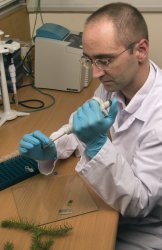Summary
 Metabarcoding is a technique of plant and animal identification based on DNA-based identification and rapid DNA sequencing. Metabarcode data sets are more comprehensive, many times quicker to produce, and are less reliant on taxonomic expertise than traditional methods (e.g. those based structural features of organisms); they also enable many opportunities for research.
Metabarcoding is a technique of plant and animal identification based on DNA-based identification and rapid DNA sequencing. Metabarcode data sets are more comprehensive, many times quicker to produce, and are less reliant on taxonomic expertise than traditional methods (e.g. those based structural features of organisms); they also enable many opportunities for research.
Forest Research is collaborating with several organisations in order to harness this novel approach for a range of applications in which monitoring of forest biodiversity is required.
Background
It is internationally recognized that maintaining the biodiversity contained in our woodlands is an integral element of sustainable woodland management. Accurate monitoring is therefore required to assess the effectiveness of forest management approaches which aim to conserve the various components of biodiversity in our woodlands. Meeting this need is hindered by the fact that traditional biodiversity assessments are expensive, time consuming, and require high-levels of taxonomic expertise. However, a combination of two recent advances offers the potential to develop alternative approaches that will be cheap, effective and free of the need for taxonomic expertise
Barcode of Life
International initiatives such as the Barcode of Life have created quality assured databases in which sequences generated in different projects can be centrally deposited and then made readily available to researchers. The Barcode of Life initiative aims to have built a reference library of five million standardized DNA sequences, which will be able to identify 500,000 species, by 2016. These sequences are based on internationally agreed regions of the genome that have been shown to provide good discrimination between species but to vary little between individuals of the same species. The most commonly used region is a 658 base pair portion of the mitochondrial cytochrome oxidase subunit I gene, commonly referred to as COI, but other regions have been found to be more suitable for plants and fungi. Care is taken to ensure that each DNA sequence is linked to a preserved specimen that has been identified to species level by a taxonomic expert.
DNA sequencing methods
Next generation DNA sequencing methods have revolutionised the number of high quality reads that can be obtained relatively cheaply from samples containing a mixture of unidentified species. This so called “metabarcoding” approach therefore can be applied to mixed species samples such as those derived from collections of arthropods in pitfall traps, bacterial and fungal communities in soil, endophytes in leaf tissue, pathogen spores in air samples or organisms in water samples. DNA is extracted and specific short regions of the genome are amplified using PCR (Polymerase Chain Reaction) based on universal primers that work across a broad range of taxa in the target organisms. These mass-amplified short fragments of DNA are sequenced and quality assured. The data set contains many duplicated sequences because each organism contributes many copies of its DNA to the PCR reaction and the next step is therefore to reduce the data so that only a single representative of each sequence or OTU (Operational Taxonomic Unit) is retained for each sample. Individual OTUs are then compared against existing DNA databases in order to identify the organisms they represent.
